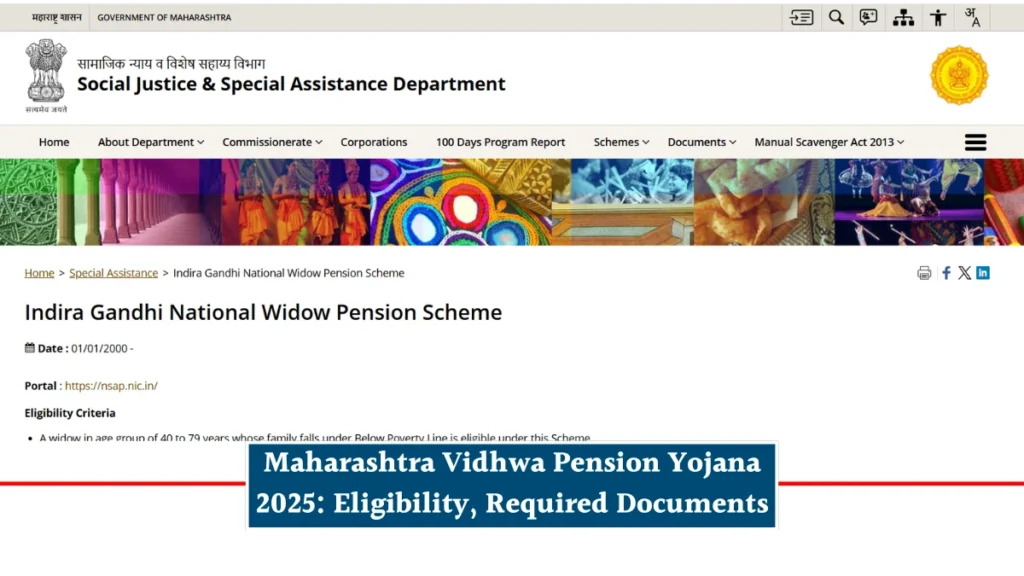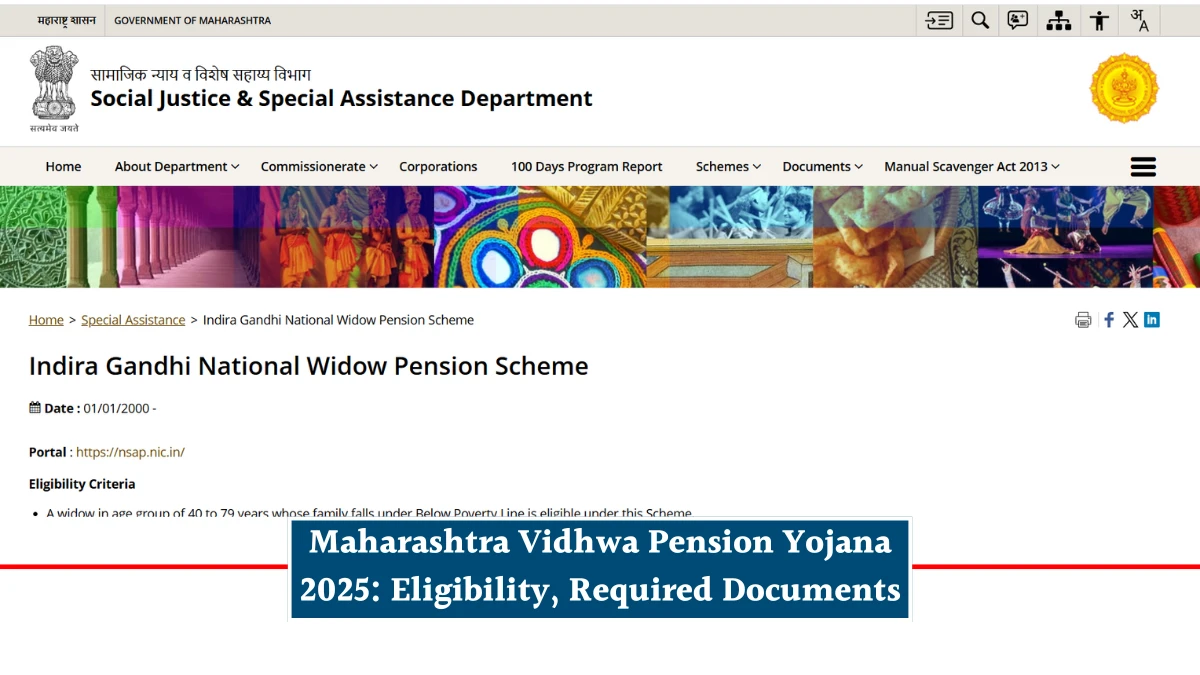Maharashtra Vidhwa Pension Yojana 2025 is a social welfare scheme launched by the Maharashtra government to provide financial support to widows living in the state. This pension scheme aims to help widows who are economically vulnerable, ensuring they have a steady source of income to meet their daily needs.
The government recognizes that widows often face financial hardships and social challenges, and this scheme is designed to ease their burden by providing monthly financial assistance. The pension helps widows maintain a basic standard of living, empowering them to lead a more dignified and independent life.

Objectives of Maharashtra Vidhwa Pension Yojana
The primary objective of the Maharashtra Vidhwa Pension Yojana is to offer economic security to widows who do not have any other source of income or support. Many widows in rural and urban areas struggle with financial instability, often lacking social security and facing discrimination. By providing a monthly pension, the scheme aims to reduce poverty and dependence among widows. It also promotes social inclusion by helping them access basic needs such as food, shelter, and healthcare. The government intends to improve the quality of life for widows and help them live with respect and self-sufficiency.
Eligibility Criteria for the Scheme
Eligibility for Maharashtra Vidhwa Pension Yojana 2025 is clearly defined to target the beneficiaries who need assistance the most. To qualify for the scheme, the applicant must be a widow residing in Maharashtra. She should belong to a family that falls below the poverty line or meet certain income criteria specified by the government. The age of the widow is usually between 18 and 60 years, though some variations in age limits may apply. The applicant should not be receiving any other pension from the government. Permanent residency proof of Maharashtra is also mandatory for applying. These criteria ensure that the pension benefits reach only the genuine and deserving widows.
Benefits Provided Under the Scheme
The Maharashtra Vidhwa Pension Yojana provides a fixed monthly pension amount to eligible widows. The exact amount can vary based on government policies and budget allocations but generally ranges between ₹1,000 and ₹2,500 per month. This pension is transferred directly to the beneficiary’s bank account via Direct Benefit Transfer (DBT) to ensure transparency and timely payment. The financial aid helps widows cover their daily expenses, including food, healthcare, and other essential needs. In some cases, additional benefits such as medical aid or subsidies might be linked with the pension scheme to provide comprehensive support.
Required Documents for Application
To apply for the Maharashtra Vidhwa Pension Yojana, applicants need to submit several important documents to verify eligibility. The key documents include a widow certificate issued by the local authorities, proof of residence in Maharashtra such as Aadhaar card or voter ID, income certificate to prove economic status, and a bank passbook or cancelled cheque for pension transfer. Other supporting documents may include identity proof like ration card, passport size photographs, and an affidavit declaring that the applicant is not receiving any other pension. Having all these documents ready can help speed up the application process and reduce delays.
How to Apply Online for Maharashtra Vidhwa Pension Yojana
Applying for the Maharashtra Vidhwa Pension Yojana online is a convenient and straightforward process. The Maharashtra government has made the application available on its official social welfare or pension portal. Applicants can visit the official website and locate the widow pension scheme section. They need to register by providing their basic details and then fill out the application form with accurate personal and family information. After submitting the form, the required documents must be uploaded in the specified formats. Once the application is verified and approved by the authorities, the pension benefits start being disbursed regularly.
Offline Application Process
For those who do not have access to the internet or prefer in-person assistance, offline applications are accepted as well. Widows can visit their nearest Gram Panchayat office, Taluka office, or the Social Welfare Department office to obtain the application form. The form needs to be filled carefully with necessary details and submitted along with all required documents. Local officials verify the information before forwarding the application for final approval. The offline process may take a bit longer than online applications but ensures that even those without digital access can benefit from the scheme.
Checking Application Status and Pension Payment
Beneficiaries can check the status of their pension application through the official government portal using their application number or Aadhaar card details. The portal provides updates on whether the application is under review, approved, or rejected. For pension payments, beneficiaries can verify the receipt of monthly installments by checking their bank accounts directly or through passbook updates. Some local offices and helplines also provide assistance in tracking the status. Keeping track of the application and payments helps beneficiaries address any issues promptly and ensures uninterrupted financial support.
Challenges and Solutions in Implementation
Like many welfare schemes, Maharashtra Vidhwa Pension Yojana faces challenges such as delayed payments, incomplete documentation, or lack of awareness among potential beneficiaries. Some widows may also struggle with the digital application process. To overcome these hurdles, the government is working on improving digital literacy, simplifying procedures, and enhancing outreach programs. Local social workers and NGOs also play a crucial role in spreading awareness and assisting widows with applications. Ensuring timely payments and transparent grievance redressal mechanisms is key to the scheme’s success and positive impact.
Social Impact of the Scheme
The Maharashtra Vidhwa Pension Yojana has a significant social impact by providing economic independence to widows. Financial support reduces their vulnerability and helps them meet basic needs without relying on others. The scheme also contributes to reducing poverty levels among widowed women and promotes gender equity by recognizing their right to social security. With increased financial stability, widows can access better healthcare, nutrition, and education for their children. Over time, such empowerment leads to stronger families and communities, fostering social harmony and development.
Future Prospects and Improvements
The government continues to evaluate and enhance the Maharashtra Vidhwa Pension Yojana to increase its reach and effectiveness. Future improvements may include raising the pension amount, expanding eligibility criteria to cover more widows, and linking the scheme with other social welfare programs for comprehensive support. Incorporating biometric authentication and mobile banking can further simplify pension delivery. Increased collaboration with NGOs and community organizations is expected to boost awareness and enrollment. Overall, the scheme is poised to become a vital part of Maharashtra’s social security framework for vulnerable women.
Conclusion
Maharashtra Vidhwa Pension Yojana 2025 is a crucial initiative aimed at uplifting widows by providing regular financial assistance. It addresses the economic hardships faced by widows and ensures they have a basic income to support themselves. With clear eligibility criteria, a simple application process, and direct pension transfers, the scheme offers a transparent and effective way to support vulnerable women. As awareness grows and administrative processes improve, the scheme will continue to empower more widows, contributing to their dignity and social inclusion.
Disclaimer: The information about Maharashtra Vidhwa Pension Yojana 2025 is for general guidance only. Applicants should verify eligibility, required documents, and application procedures through official government sources. The author is not responsible for any changes or inaccuracies in the scheme details.
